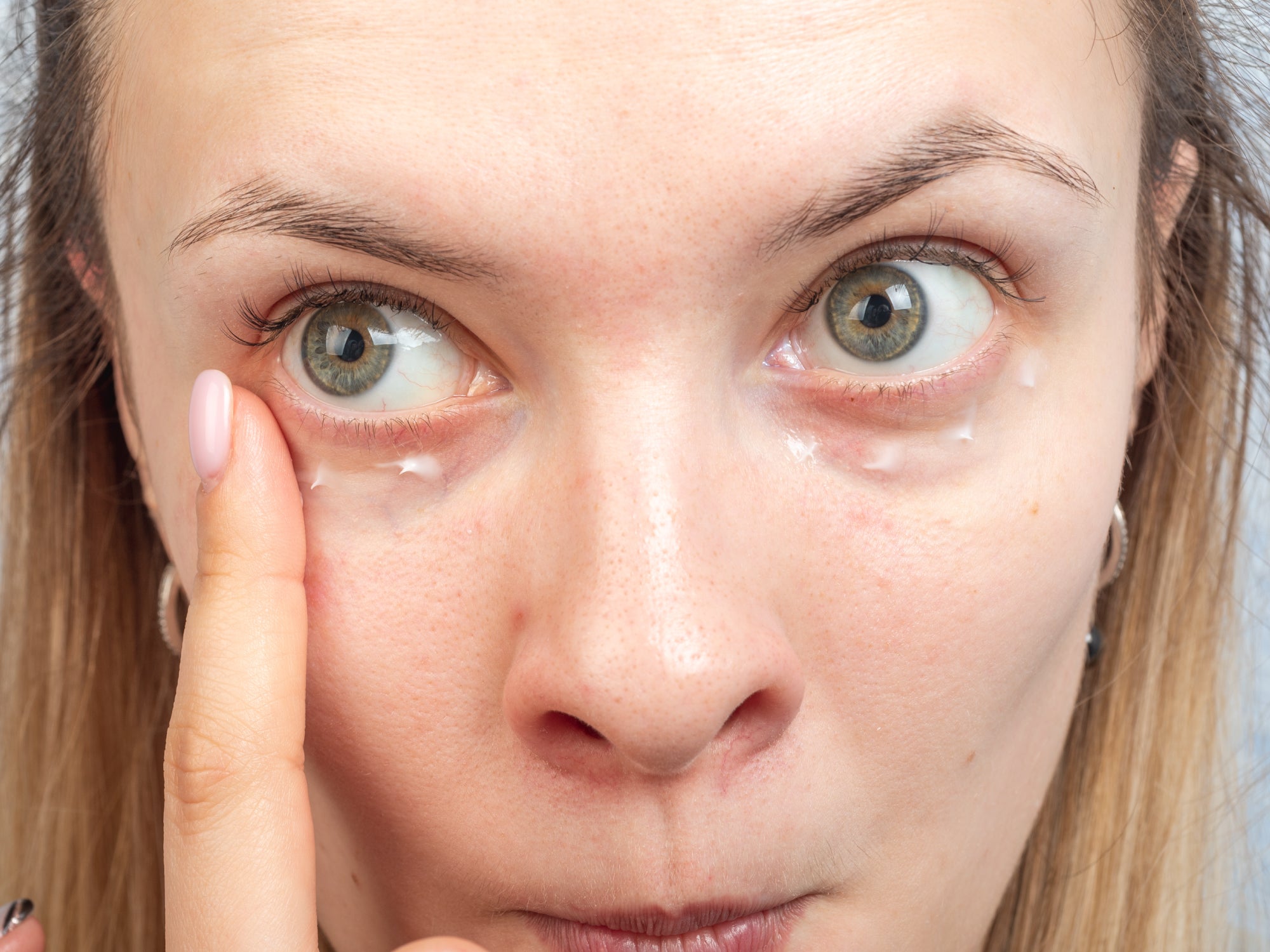Periocular dermatitis is notorious for being triggered by face creams and other cosmetics, so what can you put on that will help your skin, rather than flare it up?
That’s the million dollar question for anyone suffering from this persistent and uncomfortable problem. If medical advice is not to put anything at all on the affected area, yet your skin is crying out for moisture, what can you do?
What is periocular dermatitis?
Simply put, periocular dermatitis is an area of inflammation and irritation around the eyes. It can look a bit like eczema, rosacea, or even acne. Like perioral dermatitis, which is a similar break out around the mouth and can occur at the same time as periocular dermatitis (they’re known together as periorificial dermatitis), the skin can suffer from spots as well as dryness. See our blog What Is Periocular Dermatitis? for more information about what causes the condition.
What triggers periocular dermatitis?
One practical way of approaching the situation is to work out what NOT to put on your skin and why; if you understand the reasons for avoiding some face creams, it’ll make more sense why others can be positively beneficial for periocular dermatitis!
Occlusive ingredients
Some skincare contains ingredients that are so thick and waterproof that they can clog pores and stop the skin from ‘breathing’, making sensitive skin vulnerable to outbreaks of acne or dermatitis.
In fact, occlusive skincare has been identified as one of the major triggers for flare-ups of both perioral and periocular dermatitis (known together as ‘periorificial dermatitis’). These ingredients include paraffin, petrolatum and mineral oils, and are very common in skincare as they’re both cheap and an effective barrier against moisture-loss.
Although paraffin doesn’t affect everyone’s skin, and can be a useful ingredient to make a cream feel soft and silky while keeping dry skin from getting dehydrated, those who do suffer from periorificial dermatitis would be sensible to avoid it altogether!
Comedogenic Ingredients
As well as being affected by occlusive petrochemical oils, some people suffering from periorificial dermatitis find they need to be careful with comedogenic ingredients, which simply means oils that can cause clogged pores. As well as paraffin, synthetic comedogenic ingredients include silicones, PEGs and mineral oils.
It’s not just synthetic ingredients though: coconut oil and cocoa butter, which are both rich and hydrating natural ingredients, can also be a problem for some people. A reminder that everyone’s skin is different, and an ingredient that one person can tolerate very well could be someone else’s kryptonite!
Sunscreen
It’s unclear whether it’s the fact that high factor sunscreens can be made with paraffin or other occlusives, or if it’s the UV-blocking ingredients (such as oxybenzone) that causes sunscreens to trigger periocular dermatitis. Maybe it’s the combination of the two, but whatever the root cause, sunscreen has been pinpointed as one of the most common triggers for a periorificial flare. Sufferers who have to go out in the sun might need to trial several different hypoallergenic brands before finding one that suits their skin.
Irritant ingredients
The reason why so much skincare and cosmetics are off-limits for periocular dermatitis sufferers is likely to be their widespread use of ingredients that irritate skin. The culprits include preservatives (such as phenoxyethanol, benzyl alcohol, sodium hydroxymethylglycinate, and methylisothiazolinone), perfumes (otherwise known as parfum or fragrance), parabens and PEGs.
Topical steroid creams
Although topical steroids are widely prescribed for skin irritation, they’re now acknowledged to be responsible for a significant proportion of periorificial dermatitis, so cannot be used as treatment for the very condition they can cause!
In summary, it’s worth checking the ingredients carefully before buying a cream! Check for preservatives, occlusives, steroids, perfumes, and even the natural ingredients which can cause problems for sufferers.
What are you left with? Well, luckily some skincare can be positively good for periocular dermatitis!
What cream can you use on periocular dermatitis?
Skin affected by periocular dermatitis still needs moisture, nourishment and protection, it just doesn’t need any of the ingredients that can aggravate an attack! Although these problem ingredients are extremely common in conventional skincare and medical emollients, they aren’t in everything.
Balmonds doesn’t use occlusive paraffin or mineral oils in any of our products: we use beeswax instead, which has a low comedogenic factor and is classed as ‘semi-occlusive’ (ie breathable) rather than totally occlusive.
We also leave out the perfumes/parfums that can trigger flares, and all our oils and balms are also preservative-free. (Our shea butter creams use a tiny amount of benzyl alcohol as a preservation system, as a better alternative to the more irritant options, and our Shampoo & Body Wash uses a wholly natural preservation system.)
Adding the nutrients!
The other advantage periocular dermatitis sufferers have with Balmonds is that our products are full of low-comedogenic plant oils, which are rich in the nutrients damaged skin needs to repair itself, as well as natural anti-inflammatories to calm down hot and bothered patches.
So in conclusion, any of Balmonds’ three shea butter-based creams or Skin Salvation beeswax and hemp seed oil balm would be suitable for use on periocular dermatitis, because they’re all free from the problematic ingredients sufferers should avoid.
We’d recommend Daily Moisturising Cream or Balmonds Cooling Cream for moisturising hot and bothered skin, and Skin Salvation ointment for drier or super sensitive areas. (If your skin doesn't react well to occlusive ointments, go for creams over balms like Skin Salvation.)
Always do a patch test behind your ear or inside your elbow before using any new skincare product on your face; leave for 24-48 hrs and check for any irritation, with the caveat that the face can react more strongly even than those areas, and will sometimes not tolerate even the gentlest of natural skincare.
Recommended products:
Balmonds Skin Salvation
with hemp and beeswax
Balmonds Cooling Cream
with shea, menthol, aloe vera & lavender
Balmonds Daily Moisturising Cream
with shea butter and calendula
